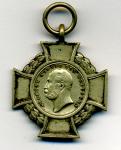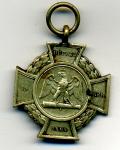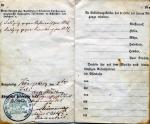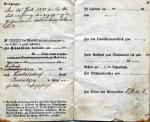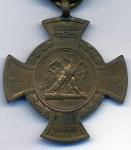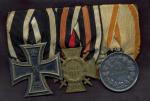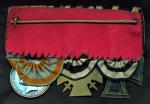-
Posts
5,629 -
Joined
-
Last visited
Content Type
Profiles
Forums
Blogs
Gallery
Events
Store
Everything posted by IrishGunner
-
New Year's Day is a time for reflection. One cannot help but wonder what thoughts went through the minds of the Kaiser's Gunners as the New Year opened on 1 January 1915. Or what were the thoughts of their comrades in the Austro-Hungarian artillery or of the allied gunners pouring counterfire down on German positions. The Centenary of the First World War in the second half of 2014 was marked publicly by solemn ceremonies and reflective discussion. But from my opinion it still was a bit subdued. Of course, the crises of the day rightfully are the priority; not to mention the day-to-day grind of simply making one's way in this complicated world. Who has time to remember the troubles of 100 years ago? What significance do bits and baubles of leftover metal, enamel, ribbon, canvas, steel or leather have today? Since so few pieces of personal documents have survived, surely they cannot be of any significance. But to serious collectors like those of us here at GMIC, these things do matter. Sometimes I think we collect - and remember - both the heroic and the mundane (not only of the First World War, but from all the periods in which we find our collecting interest), with the simple hope that one day, we too will be remembered. History is often looked down upon by many (especially school children and students) as just old things and dead people in a book. Okay, well maybe as just old things and dead people on a Wikipedia web page. They fail to see that post cards from a soldier in the trench were the Twitter feed of today. They fail to see that hand-written diaries are the equivalent of a Facebook page. More importantly, they fail to see that history is around them every day: in the news, in their neighborhood, in their neighbors' lives, and in their own lives. Students understandably question why they should learn about people, places, and events in the past; we as "historians" and "teachers" have failed to show them relevancy. As a collective society, we must inspire each other to have a natural curiosity and awareness about the past so that we see how it affects the present. Perhaps then, armed with this knowledge, we can become active participants in shaping a better future for our communities, both locally and globally. This is why I believe the discussion we had earlier on GMIC about the causes of the First World War was so important. And this also is why these bits and baubles we collect are so important. They are tangible. They are a spark for curiosity. As collectors, I do believe that we serve a larger purpose of preserving history. One trend that continued in 2014 is especially troubling: the closing of brick-and-mortar museums. The scaling back in the scope of the Royal Artillery Museum "Firepower" in Woolwich, England due to budget issues announced in May 2014 is only one example. (Unfortunately, this trend started long ago in the United States with the scraping of the US Army Ordnance Museum in 2007.) It is perhaps inevitable. Reflecting on my own collecting past of 2014, I too scaled back due to budget. In 2014, I continued in earnest my transition from a lucrative consulting career to a career in education, with its corresponding scale back in remuneration. Consequently, my largest single collecting purchase in 2014 cost less than $100; a 1914 Mons Star to a Royal Artillery Gunner. It did not cost a great deal, but it means a great deal to me in terms of my current collecting motivation - history. I did not previously have a 1914 Star in my collection; adding one in 2014 seemed most appropriate. I have yet to research the medal; nonetheless, that brings me to my next reflection and moves this rambling tome on to its next phase - resolution. I didn’t collect much in 2014; I only added 10 new regiments in my effort to collect something representing every Imperial German artillery regiments. On the other hand, I researched more of the history behind my items. While quite basic, I enjoyed researching and writing the first four articles in the series “Artillery of the First World War” for GMIC Articles: Germany, France, Belgium, and Russia. I also wrote a special edition, “The Royal Artillery at Mons” and a piece on the “Königlich Bayerisches 12. Feldartillerie-Regiment (12. bFAR).” An article on the effect of large scale artillery bombardments in the First World War is in very rough draft. So, I resolve to spend less money on stuff and more time on research and writing in 2015. I am certain that The Chancellor of the Household Exchequer will ensure I keep this resolution! Like many of us, my collection rambles outside the boundaries of my main focus on artillery in the First World War. So, I also resolve to liquidate some of the more far-flung pieces; of course, if I can construe even the slightest connection to artillery, it will stay. The Chancellor may have to intervene to enforce rigor and discipline in the culling process. Realizing that one well-aimed shot can be more effective than several hundred tons of high explosive, I will wrap up this New Year's missive with one simple challenge: share your collecting reflections and resolutions for 2015.
-
"Old tech" true, but still revolutionary in many ways. The French first fielded the 75mm in 1897, but closely guarded its specs. Nonetheless, I agree it wasn't for "reverse engineering." The US Army decided to go with 75mm as its standard caliber (as opposed to 3in) in spring 1917 and entered negotiations with the French to produce the field guns in the US under license. French advisers came to the US and US ordnance officers went to French arsenals to coordinate manufacture. So, no reason to be skeptical Hoss. There were already 75's in the US and plans underway to manufacture them by the time the first US 75mm rounds were fired at the Germans.
-
I hear you dude! I've spent more of my time pouring over Imperial German stuff as well. And like I said, I'm embarrassed because this is my regiment! I should already know the whole story. Nonetheless, this has opened an excellent discussion and point for research. You both have added great info that is helpful.
-
Art, that old photo on the Facebook page isn't in France. Read the caption. It's a photo of the West Point gun in its old display in Taylor Hall (Ordnance Museum) and now in its display where you saw it at Large Weapons Gallery. I didn't go to West Point; so, I have no personal knowledge of this gun. I don't live far from either Aberdeen or Fort Lee; so, if we can find Bridget's current location, I just might make a trip. And unfortunately, I don't own a copy of the 6th FA WWI history. Had a chance to get one, but lost the auction. Only by a few bucks. I wasn't happy. Wonder if anyone has the 1st Infantry Division official history; that might help.
-
The US National Archives has a photo captioned: Battery C, 6th Field Artillery, US Army firing French-built 75mm field gun 'Bridget', France, 1917-1918 In my experience, these Signal Corps photos are "staged" and not depicting real action. This photo, in my opinion, fits into that category. Given the anecdote that Art describes about pulling the gun by hand a half mile into position, I doubt there was a photographer present. (Of course, that story sounds a bit fanciful to me as well.) Could the first gun - the West Point gun - have already been taken away for safe-keeping and this was it's replacement named Bridget and posed for this photo? The paper trail on the two guns seems most important.
-
Certainly, there was more than one gun with C Battery, 6th Field Artillery. By organization there were 4 guns in a battery; 24 to a regiment in 6 batteries. I suppose the honor of highest distinction goes to the gun section that fired the very first round, vice all of the guns firing rounds in the first action.
-
Gentlemen, I think there has been one of those cases where "insult" was read into a post on the internet where none was intended simply because the intent of the written word on the internet is sometimes misunderstood. I don't believe ralstona intended any insult in his description of US "eagerness". I read it as "over eagerness" by the Yanks because they didn't understand life on the front quite as well as the experienced French. It is well documented that the US soldiers were "eager" and didn't always accept the wisdom of their more experienced French teachers. There are some conflicting "facts" - some taken from a personal visit to the museum at West Point and some taken from Wikipedia. How about we return to the discussion, without implied or misconstrued "hostility," and resolve this interesting twist of two guns claiming the lineage?
-
Well, I'm embarrassed to say that since this is my regimental history, I should know more, but I knew the gun existed, but did not know where it was displayed. It seems we have two guns "claiming" the lineage. One at the West Point Museum as shown by ralstona and one from Wikipedia posted by Hoss. Wikipedia claims "Bridget" was at the US Army Ordnance Museum at Aberdeen Maryland, but that has been closed and the displays moved to the Quartermaster Museum at Fort Lee, Virginia. A bit of detective work may be called for...
-

EK All Eras Welcome Brian R...
IrishGunner replied to Chris Boonzaier's topic in Germany: All Eras: The Iron Cross
More like a YouTube documentary. -

United States US Army Heraldic Crests
IrishGunner replied to speagle's topic in United States of America
Is there a particular order to the display? I would obsessed with putting artillery next to artillery, infantry next to infantry, in numerical order. Do you have a focus or collect what comes along? I usually take a look at the unit history before buying. -

Falklands Medal Rosette
IrishGunner replied to Wilhelmina's topic in Great Britain: Orders, Gallantry, Campaign Medals
The end date for qualifying for the medal was 14 June 1982 - the date of the Argentine surrender - so someone working on the island after hostilities ceased would not qualify. -

Falklands Medal Rosette
IrishGunner replied to Wilhelmina's topic in Great Britain: Orders, Gallantry, Campaign Medals
Wilhelmina, welcome to the Forum! The word "Gentleman" in the title isn't meant to exclude women - it's rather a reflection of a general spirit of respectful discourse. We have several active Ladies and are happy you joined! After having read the award criteria for the South Atlantic Medal, I must say I too am confused about the rosette distinction. Maybe one of our British members can chime in with some more clear explanation. In the meantime, I've read that PM David Cameron has recently awarded the SAM to the entire Falkland Islands. David Cameron is awarding the South Atlantic medal to Falklands Islands: The Prime Minister honours heroes 32 years after the conflict by awarding the medal collectively to the islands in his Christmas message. -

Air Force Debuts New Service Medal
IrishGunner replied to IrishGunner's topic in United States of America
Did he apply for disability? Sounds like he needs to contact a Veteran's Service Officer (VSO) at either the American Legion or VFW (he doesn't need to be a member); they can guide him through the claims process. I am certain he'll get service connected disability for the hearing loss at least. If you have questions PM me. -

EK 1914 Spoon anyone?
IrishGunner replied to Chris Boonzaier's topic in Germany: All Eras: The Iron Cross
Yea, I had that same hesitation...



